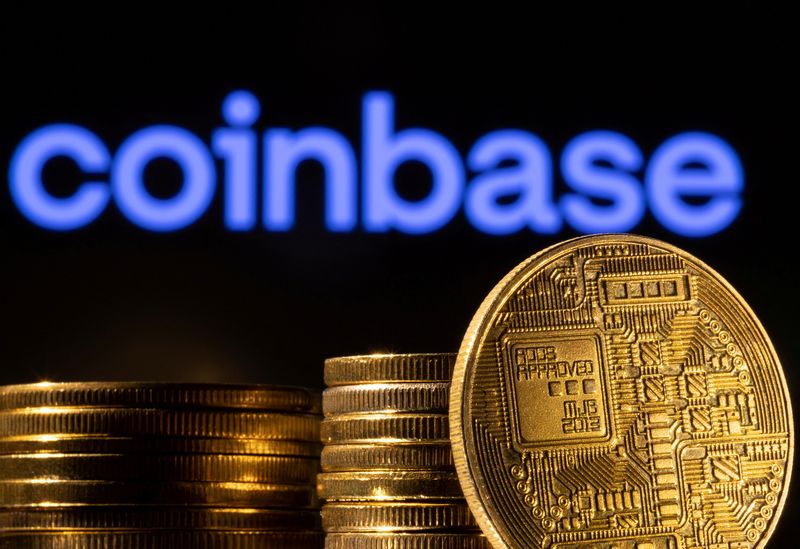Investing.com -- Moody's lowers its outlook on Coinbase, citing concerns over a lawsuit brought against the cryptocurrency exchange by U.S. authorities. Elsewhere, inflation data out of China disappoints and exacerbates worries that the country's nascent post-pandemic recovery could be running out of steam.
1. Moody's downgrades Coinbase outlook
Moody's has cut its rating of Coinbase (NASDAQ:COIN) after U.S. regulators unveiled a lawsuit against the cryptocurrency exchange earlier this week.
In a statement on Thursday, the credit rating agency downgraded its outlook to "negative" from "stable," citing concerns over how the claims could impact the company's "business model and cash flows."
The Securities and Exchange Commission sued Coinbase on Tuesday, alleging that the platform had broken U.S. law by failing to register as an exchange.
The move came as part of a wider crackdown on the crypto industry, which SEC chair Gary Gensler has likened to the "Wild West." On Monday, the SEC also took legal action against Binance, the world's biggest cryptocurrency exchange.
2. Trump faces historic indictment
Former U.S. President Donald Trump has reportedly been indicted by a federal grand jury over the mishandling of classified documents, making him the first former president to face charges brought by the federal government.
Citing a person familiar with the situation, the Wall Street Journal said Trump was charged with seven counts, including obstruction and false statements. Speaking to CNN, a lawyer representing Trump confirmed the counts.
Trump himself sounded off on the issue on social media, saying that he had been informed by his lawyers that he was being indicted in connection with the handling of secret documents at his Mar-a-Lago residence in Florida. He added that he had been summoned to appear before a federal court in Miami.
The Justice Department has yet to provide an official comment.
Legal problems are growing for Trump, who is also running for the presidency in 2024. He has also been charged with falsifying business records in a state court. Trump has denied the accusations.
3. Chinese inflation print highlights stuttering recovery
Factory gate prices in China tumbled at their fastest pace since 2016 in May, while consumer prices rose by less than expected, as concerns build over demand in the world's second-largest economy.
While the U.S. and Europe wage an ongoing battle to corral elevated inflation, China could be facing the opposite problem. A first-quarter surge in activity following the lifting of pandemic-era restrictions is seemingly beginning to wane, with analysts warning that recent data may be suggesting that the country is edging into deflation and a broader economic slowdown.
China's producer price index slipped last month, down 4.6%, according to figures from the National Bureau of Statistics. It was the eighth straight monthly decline. Meanwhile, consumer prices increased by 0.2% on an annual basis, ticking up slightly from the April reading but missing forecasts for a 0.3% rise.
Friday’s dismal inflation prints come despite several efforts by Beijing to shore up local liquidity. China’s biggest state-run banks cut interest rates on yuan deposits this week, potentially heralding a broader interest rate cut by the People’s Bank.
4. Futures mixed after S&P 500 closes at 2023 high
U.S. stock futures were mixed on Friday after the benchmark S&P 500 jumped to its highest closing level so far this year in the prior session.
The main indices all finished in the green in the previous day's regular session, with the S&P 500 adding 0.62% to 4,293.93 -- its highest close in 2023. The broad-based Dow Jones Industrial Average rose by 0.50%, while the tech-heavy Nasdaq Composite surged by 1.02%.
Both the S&P and Dow are on pace to post weekly gains, although the Nasdaq is on track to end a six-week winning streak.
5. Oil volatile after weak Chinese data
Oil prices were choppy on Friday after the inflation data out of China stoked further worries that the world's biggest oil importer may be seeing a slowdown in economic growth that will weigh on demand this year.
Meanwhile, the U.S. and Iran have both denied reports that they are close to reaching a nuclear deal. The statements helped quash speculation that Iran would begin to supply crude to global markets, supporting prices
